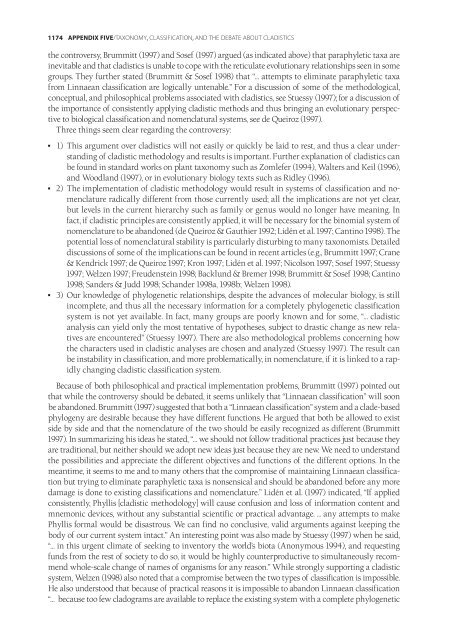Appendices & Glossary - Botanical Research Institute of Texas
Appendices & Glossary - Botanical Research Institute of Texas
Appendices & Glossary - Botanical Research Institute of Texas
You also want an ePaper? Increase the reach of your titles
YUMPU automatically turns print PDFs into web optimized ePapers that Google loves.
1174 APPENDIX FIVE/TAXONOMY, CLASSIFICATION, AND THE DEBATE ABOUT CLADISTICS<br />
the controversy, Brummitt (1997) and Sosef (1997) argued (as indicated above) that paraphyletic taxa are<br />
inevitable and that cladistics is unable to cope with the reticulate evolutionary relationships seen in some<br />
groups. They further stated (Brummitt & Sosef 1998) that “… attempts to eliminate paraphyletic taxa<br />
from Linnaean classification are logically untenable.” For a discussion <strong>of</strong> some <strong>of</strong> the methodological,<br />
conceptual, and philosophical problems associated with cladistics, see Stuessy (1997); for a discussion <strong>of</strong><br />
the importance <strong>of</strong> consistently applying cladistic methods and thus bringing an evolutionary perspective<br />
to biological classification and nomenclatural systems, see de Queiroz (1997).<br />
Three things seem clear regarding the controversy:<br />
▪ 1) This argument over cladistics will not easily or quickly be laid to rest, and thus a clear understanding<br />
<strong>of</strong> cladistic methodology and results is important. Further explanation <strong>of</strong> cladistics can<br />
be found in standard works on plant taxonomy such as Zomlefer (1994), Walters and Keil (1996),<br />
and Woodland (1997), or in evolutionary biology texts such as Ridley (1996).<br />
▪ 2) The implementation <strong>of</strong> cladistic methodology would result in systems <strong>of</strong> classification and nomenclature<br />
radically different from those currently used; all the implications are not yet clear,<br />
but levels in the current hierarchy such as family or genus would no longer have meaning. In<br />
fact, if cladistic principles are consistently applied, it will be necessary for the binomial system <strong>of</strong><br />
nomenclature to be abandoned (de Queiroz & Gauthier 1992; Lidén et al. 1997; Cantino 1998). The<br />
potential loss <strong>of</strong> nomenclatural stability is particularly disturbing to many taxonomists. Detailed<br />
discussions <strong>of</strong> some <strong>of</strong> the implications can be found in recent articles (e.g., Brummitt 1997; Crane<br />
& Kendrick 1997; de Queiroz 1997; Kron 1997; Lidén et al. 1997; Nicolson 1997; Sosef 1997; Stuessy<br />
1997; Welzen 1997; Freudenstein 1998; Backlund & Bremer 1998; Brummitt & Sosef 1998; Cantino<br />
1998; Sanders & Judd 1998; Schander 1998a, 1998b; Welzen 1998).<br />
▪ 3) Our knowledge <strong>of</strong> phylogenetic relationships, despite the advances <strong>of</strong> molecular biology, is still<br />
incomplete, and thus all the necessary information for a completely phylogenetic classification<br />
system is not yet available. In fact, many groups are poorly known and for some, “… cladistic<br />
analysis can yield only the most tentative <strong>of</strong> hypotheses, subject to drastic change as new relatives<br />
are encountered” (Stuessy 1997). There are also methodological problems concerning how<br />
the characters used in cladistic analyses are chosen and analyzed (Stuessy 1997). The result can<br />
be instability in classification, and more problematically, in nomenclature, if it is linked to a rapidly<br />
changing cladistic classification system.<br />
Because <strong>of</strong> both philosophical and practical implementation problems, Brummitt (1997) pointed out<br />
that while the controversy should be debated, it seems unlikely that “Linnaean classification” will soon<br />
be abandoned. Brummitt (1997) suggested that both a “Linnaean classification” system and a clade-based<br />
phylogeny are desirable because they have different functions. He argued that both be allowed to exist<br />
side by side and that the nomenclature <strong>of</strong> the two should be easily recognized as different (Brummitt<br />
1997). In summarizing his ideas he stated, “… we should not follow traditional practices just because they<br />
are traditional, but neither should we adopt new ideas just because they are new. We need to understand<br />
the possibilities and appreciate the different objectives and functions <strong>of</strong> the different options. In the<br />
meantime, it seems to me and to many others that the compromise <strong>of</strong> maintaining Linnaean classification<br />
but trying to eliminate paraphyletic taxa is nonsensical and should be abandoned before any more<br />
damage is done to existing classifications and nomenclature.” Lidén et al. (1997) indicated, “If applied<br />
consistently, Phyllis [cladistic methodology] will cause confusion and loss <strong>of</strong> information content and<br />
mnemonic devices, without any substantial scientific or practical advantage. … any attempts to make<br />
Phyllis formal would be disastrous. We can find no conclusive, valid arguments against keeping the<br />
body <strong>of</strong> our current system intact.” An interesting point was also made by Stuessy (1997) when he said,<br />
“… in this urgent climate <strong>of</strong> seeking to inventory the world’s biota (Anonymous 1994), and requesting<br />
funds from the rest <strong>of</strong> society to do so, it would be highly counterproductive to simultaneously recommend<br />
whole-scale change <strong>of</strong> names <strong>of</strong> organisms for any reason.” While strongly supporting a cladistic<br />
system, Welzen (1998) also noted that a compromise between the two types <strong>of</strong> classification is impossible.<br />
He also understood that because <strong>of</strong> practical reasons it is impossible to abandon Linnaean classification<br />
“… because too few cladograms are available to replace the existing system with a complete phylogenetic
















